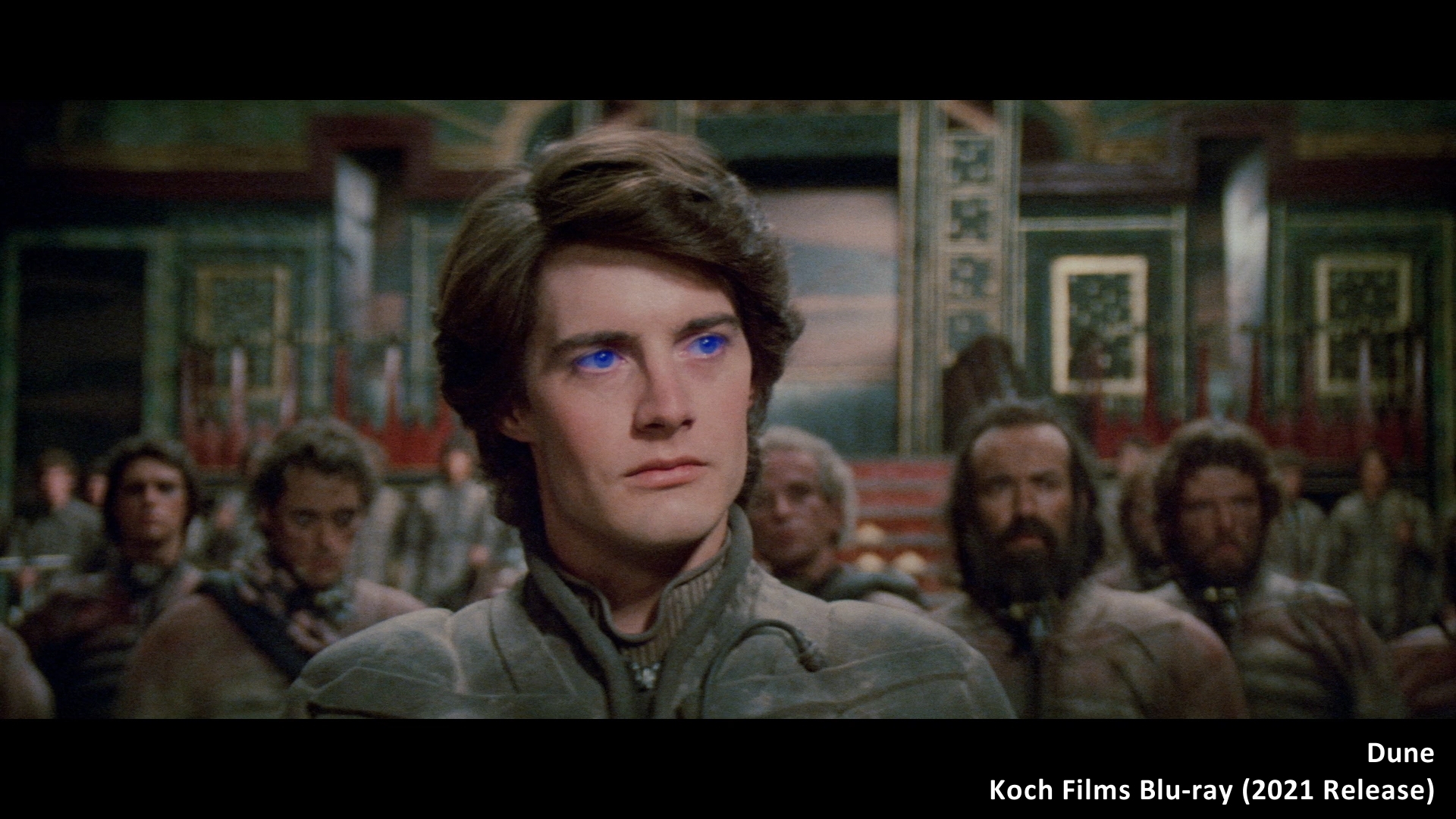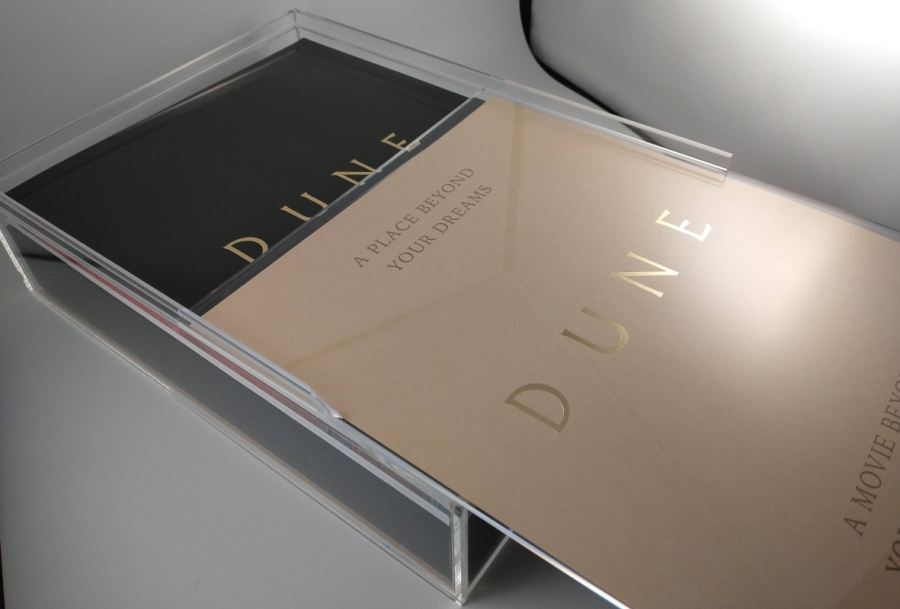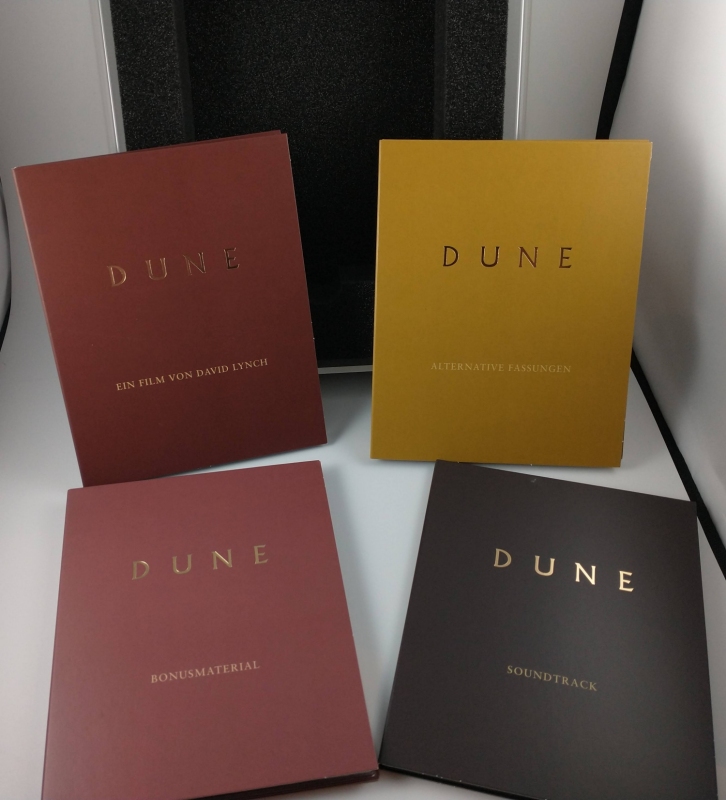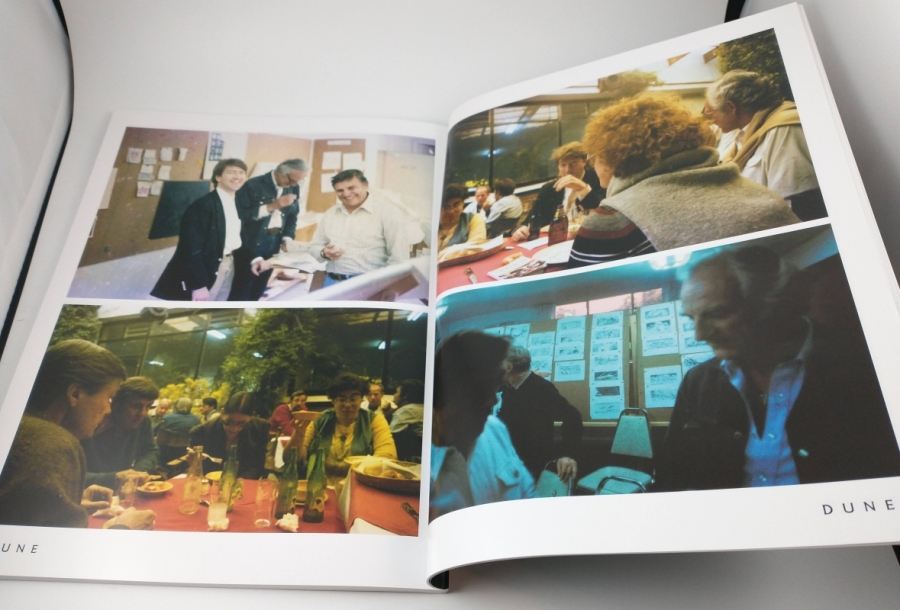David Lynch’s 1984 adaptation of Frank Herbert’s famed science fiction novel Dune is my favorite movie. This is, typically, not an easy thing to explain to people. The film was a tremendous critical and box office failure in its day. The fact that its recent remake (or re-adaptation of the source material, if you must) was greeted with far more success and acclaim hasn’t helped matters. Lynch’s Dune is usually remembered or regarded in derogatory terms, as something fundamentally broken that could only be fixed by wiping the slate clean and starting over from scratch. Even the director hates it and has disowned it.
None of that changes my opinion or affects my feelings about it. I love Lynch’s Dune. I’ve watched it countless times and always feel like I find something new to appreciate in each viewing. I own numerous copies of the movie on almost every home video format that has ever existed. I’ve amassed a sizable collection of memorabilia devoted to it. A corner of my home theater room is dedicated to a Dune shrine. The way other people may have more socially acceptable movie obsessions with things like Star Wars or the Marvel Cinematic Universe, I am obsessed with Dune. And, to be very clear about it, I am specifically obsessed with David Lynch’s 1984 version of Dune.

| Title: | Dune |
| Year of Release: | 1984 |
| Director: | David Lynch |
| Watched On: | 4K Ultra HD Blu-ray |
| Also Available On: | Starz Various VOD rental and purchase platforms |
I’ve written reviews in the past that explain what I like about the movie, even while acknowledging its weaknesses and flaws. The best of those was published at High-Def Digest. I don’t feel the need to do all that again here right now.
I first approached Dune not as a fan of the Frank Herbert novel. I hadn’t read the book until after watching the movie, so its failure to be a word-for-word faithful illustration of the text never bothered me. Nor did I ever look at it expecting the next Star Wars-style space opera blockbuster, the way that audiences of 1984 certainly did. I didn’t even see the movie until half a dozen years after-the-fact. I came at Dune first and foremost as a fan of filmmaker David Lynch, whose television series Twin Peaks blew my 16-year-old mind wide open in the spring of 1990. From the opening moments of that show’s pilot episode, I immediately knew that I’d need to watch everything this guy had ever done. At the time, with my primary resource for such things being the local Blockbuster Video, I was lucky to find copies of Lynch’s black-and-white historical drama The Elephant Man and controversial mystery thriller Blue Velvet. (Lynch’s debut feature, the Surrealist art piece Eraserhead, was not readily available on home video in those days.) Blue Velvet, especially, had very clear thematic and stylistic connections to Twin Peaks, and really opened my eyes to the possibilities of filmmaking as a medium of expression for an artist with a distinctive voice, in ways that I had never considered previously. Lynch was my first filmmaking idol.
Dune was always an anomaly in David Lynch’s career, a big-budget studio sci-fi picture from an art film director who’d never made anything like it before and never would again. It was also a notorious flop, infamous as one of the biggest box office bombs of all time and utterly reviled by critics during its release. Siskel & Ebert, the most prominent voices in American film criticism, both called it the worst movie of 1984, and were joined in that assessment by a majority of their colleagues. Audiences agreed. It seemed that just about everybody hated Dune, including Lynch himself, who considered it a sell-out project that he’d regret for the rest of his life (and still does).
I knew all this going in. I figured the movie would probably be awful, but hoped I could at least pick out a faint glimmer of the talent Lynch would bring to his other works. As just about the only mainstream movie he’d ever made, yet very unpopular, Dune was readily available in the Science Fiction section at Blockbuster with no concerns about copies being rented out.
I don’t remember exactly what I thought of it during my first viewing, but I didn’t hate it. The movie had a lot more going on than I expected, both narratively and stylistically. Even in awful quality VHS video with half the widescreen photography cropped out from the pan & scan transfer, it felt unlike any other sci-fi movie I’d ever seen. And while I definitely recognized Lynch’s hand in it, the movie also wasn’t much like Blue Velvet or Twin Peaks either. Dune was decidedly its own thing.
I don’t know that I loved Dune that first time through, but I was intrigued. I needed to watch it again. I’m pretty sure I ran that tape three or four times before returning it to Blockbuster. I later read the book, which greatly filled in a lot of the story details that were admittedly muddled or confusing in the movie. I liked the book well enough, but found it curiously missing almost any visual description of the universe it created, which was the greatest strength of the movie adaptation. Through his production design, sets, costumes, and photography, Lynch took great pains to establish four distinct worlds, each with its own culture and history unlike the others. Whereas Frank Herbert filled in that backstory through reams of lengthy exposition, Lynch conveyed it visually. I couldn’t read the book without seeing the Lynch film in my head. Herbert himself made similar statements during its release:
“I get asked the specific question a lot of times, if the settings, the scenes that I saw in David’s film match my original imagination, the things that I projected in my imagination. And I must tell you that some of them do precisely. Some of them don’t, and some of them are better. Which is what you would expect of artists such as David and Tony Masters, and I’m delighted with that. I mean, why not take it and improve on it visually? As far as I’m concerned, the film is a visual feast. I would love to have some of the scenes, as stills, to frame and have around me.”
Dune: A Recorded Interview – WaldenTapes audio book ©1984
I eventually bought my own copy of the VHS tape. Many more viewings followed, and with each one my appreciation grew. I knew that it wasn’t, objectively, Lynch’s best movie, but something about it kept bringing me back, fostering an obsession that would quickly escalate.
I’ll be honest, the fact that Dune is so widely disliked gives it an underdog quality that appeals to me. This was a big-budget sci-fi picture produced in the wake of Star Wars, and was likewise expected to launch a major franchise of sequels. (Herbert had written five books in the series by that point, with a sixth on the way.) Yet the movie doesn’t look or behave like any other blockbuster hopeful. Tonally, it’s a very expensive art film, filled with idiosyncratic (and often grotesque) details that aren’t in the book and sprang from Lynch’s imagination, not Herbert’s. How could anyone have possibly expected this to win over a mass audience?
In that regard, Lynch’s Dune seems like it was always destined for cult fandom. Indeed, that’s exactly what happened. Over the years, despite its general unpopularity, the film has built a small yet ardent following that a handful of home video labels around the world have courted with deluxe collectible releases on DVD, Blu-ray, and now 4K Ultra HD. At least a couple of those have already proclaimed themselves to be “Ultimate Editions,” but the mammoth box set from Koch Films in Germany may come closest to actually earning that title.
The Box Set
The new 4K remaster of Dune was prepared by Koch Films, a division of German software and video game distributor Koch Media. However, that work actually first hit the market under license to Arrow Video, which released it on Ultra HD Blu-ray simultaneously in the UK and the United States in August 2021, timed to piggyback on publicity for the Denis Villeneuve remake. The first German releases from Koch Films itself (in 3-disc SteelBook and Mediabook packaging options) were delayed a couple months in order to await completion of a new feature-length making-of documentary. Arrow opted to move forward on the original planned release date without that documentary. (The piece later ran on Arrow’s streaming service.) Koch’s Ultimate Edition box set was further delayed an additional four months, pushed back into early 2022.
The Ultimate Edition indeed aspires to be the ultimate home video release of Dune. Contents are spread across seven discs:
- Feature film (4K Ultra HD Blu-ray)
- Feature film (Blu-ray)
- MCA TV “Alan Smithee” extended edition (Blu-ray)
- “Spicediver” fan edit (Blu-ray)
- New bonus features (Blu-ray)
- Archival bonus features (Blu-ray)
- Soundtrack CD
Be aware that, although the Ultra HD Blu-ray format has no region coding and can be played anywhere in the world, the other five standard Blu-rays in the set are locked to Region B and will require compatible hardware to watch.
The collection comes in an oversized acrylic box also housing a glossy book of photos and artwork, a German translation of the original 1984 Marvel graphic novel adaptation, and a couple posters. Bundled alongside all this is a double-sided metallic art placard that won’t fit inside the box.
While this is an elaborate product with enough heft to feel like a premium collectible, I’m not sure what the coffin-like design has to do with Dune, per se. The package configuration makes getting any of the contents out an awkward challenge. The clear acrylic and the glossy book cover are also magnets for fingerprints and smudges. I often feel the need to put on white gloves before I touch anything in this set.
Initially sold only through the Koch Films web site, the Ultimate Edition was very difficult to import to the United States. I needed to have my order shipped to a friend in Europe who forwarded it on to me. Sadly, the acrylic box is rather fragile, and mine arrived with a chip broken off of one corner.
The Ultra HD Blu-ray
I own and have watched a lot of different copies of Dune on home video, ranging in quality from abysmal to very satisfying. I’ve also seen the movie projected on 35mm a couple times. The Koch Films 4K Ultra HD edition is, paradoxically, both the best version of the film available and also a little underwhelming. I say the latter because, honestly, it doesn’t look terribly dissimilar to the American Blu-ray edition released by Universal Studios back in 2010.
This isn’t entirely a problem. I’ve long argued that the American Blu-ray was the standard-bearer for Dune in 1080p high definition, besting even a bunch of foreign remasters that followed it. That disc has an excellent sense of detail, texture, and depth, as well as good colors. The only disappointment I had with it was the presence of some light speckling and dirt on the film elements. Personally, I didn’t find this issue overly distracting (it was no worse than watching a typical 35mm film print at a theater), but it did leave the disc looking a little less pristine than some viewers may have expected. Otherwise, that Blu-ray has held up nicely in the decade since its release.
Despite Koch reportedly remastering the film from the original camera negative, the bump up to 4K resolution doesn’t gain the movie much, beyond perhaps looking grainier in some scenes. I expect that its photography never had much more detail than 1080p was sufficient to reproduce. In fact, while the new 4K copy looks very comparable to the old Universal Blu-ray, the accompanying downsampled Blu-ray from Koch looks a little softer than Universal’s transfer – in some shots a lot softer.


While both are presented in the movie’s original 2.35:1 aspect ratio, Koch’s transfer has slightly more image around the edges than Universal’s, but that’s not unusual for two different film scans performed on different equipment years apart, and the difference isn’t enough to be noticeable during playback. That’s the sort of thing you only catch when doing screenshot comparisons.
The High Dynamic Range grade feels like a missed opportunity, as the image has almost no sense of HDR. Black levels aren’t especially deep and bright highlights aren’t notable. If anything, the contrast seems a little flat. I also tend to prefer the slightly richer colors in Universal’s transfer, but I can’t know for certain which is supposedly more accurate to Freddie Francis’ photography.
On the other hand, Koch did put some effort into cleaning up most (if not necessarily all) of the dirt and damage that troubled the Universal disc. That gives it enough of an edge to make the 4K edition my new default viewing copy.
In my best attempts to compare them, the DTS-HD Master Audio 5.1 soundtrack on the Koch (and Arrow) discs seems thinner in bass than Universal’s offering, but this is difficult to quantify since both tracks are set for very different default volumes that I had trouble matching. As a movie from 1984, Dune was never a bass powerhouse in the first place, but it has a fascinating sound design with many unusual sound effects and a pretty great score by rock band Toto. Overall, both copies convey that well and are very listenable. If I had to choose, I think Universal has an advantage in sound quality, but not enough to prevent me from watching the Koch disc.
Bonus Features
The Ultimate Edition box set is loaded with supplemental content, both new and old.
Both the Ultra HD and regular Blu-ray discs that house the feature include identical contents:
- German Trailer (3 min.) – Promoting the German release title of Der Wüstenplanet, and dubbed into German, this foreign trailer is notable for opening with a striking effects shot not actually found in any cut of the movie. It also freely divulges a pretty blatant plot spoiler in the middle.
- English Trailer (3 min.)
- English Teaser Trailer (2 min.)
Bonus Material Disc 1 is included with all Koch Films releases, whether SteelBook, Mediabook, or this Ultimate Edition.
- The Sleeper Must Awaken (82 min.) – This new documentary by Ballyhoo Motion Pictures is the piece that Arrow Video dropped from physical disc releases at the last minute. The doc covers previous failed attempts to adapt the Frank Herbert novel, script development of the 1984 film, design, casting, costumes, filming in Mexico, special effects, editing, and more. Although very thorough in many respects, it makes no mention of some of the serious production troubles that plagued the shoot (including a bout of food poisoning that wiped out most of the cast and crew), it skims lightly over the film’s ultimate financial failure, and it also perpetuates the myth of the so-called “5-hour director’s cut” that has already been debunked by producer Raffaella De Laurentiis.
- Beyond Your Imagination: The Merchandise (23 min.) – Brian Stillman, producer of Netflix’s The Toys That Made Us, provides a look at some of the tie-in merchandise released in 1984 to promote the movie. Mostly, he focuses on the LJN line of action figures and toys.
- Prophecy Fulfilled: The Film Music (25 min.) – Among other tidbits, we’re told that Toto turned down an offer to score Footloose in order to do Dune instead.
- Interview with Actor Jürgen Prochnow (28 min.) – This interview is exclusive to Koch Films, but unfortunately it was conducted in German and Koch does not offer English subtitles.
- Interview with Makeup Artist Giannetto De Rossi (17 min.) – Likewise, this interview is in Italian and Koch Films only provides German subtitles. However, the same interview is found with English subtitles on the disc releases from Arrow Video.
- Photo Gallery – Posters, publicity photos, behind-the-scenes shots, design sketches, and images from the movie’s press kits in German, French, and Japanese.
Bonus Material Disc 2 is comprised of “archival” content collected from various older DVD and Blu-ray releases (both American and European) or other sources. This disc is only found in the Ultimate Edition set, not in the Koch Films SteelBook or Mediabooks. Note that most of the material is encoded in PAL standard definition.
- Destination Dune (6 min.) – The vintage promotional featurette from 1983 contains a brief look at the excised Caladan garden scene not found in any edition of the movie.
- Impressions of Dune (35 min.) – A documentary from 2004 features interviews with Kyle MacLachlan, Raffaella DeLaurentiis, Freddie Francis, and others involved with the original production, plus author Harlan Ellison and film critic David Ansen, who were two of the movie’s biggest defenders.
- Designing Dune (9 min.) – Craftsmen who worked on the film discuss the art design.
- Die Modelle (7 min.) – A.K.A. Dune Models and Miniatures. The title is clear enough about what this discusses.
- Die Spezialeffekte (6 min.) – A.K.A. Dune FX.
- Die Kostüme (5 min.) – A.K.A. Dune Wardrobe Design.
- Interview with Actor Paul Smith (13 min.) – Conducted in 2007, the Beast Rabban actor tells stories from his time making Dune, of which he insists he had great fun despite the difficulty of the shoot.
- Interview with Production Coordinator Golda Offenheim (26 min.) – Interviewed in 2003, the woman describes David Lynch as “a crackpot but a genius” and says she found Frank Herbert to be a strange and difficult man.
- Sean Young’s Super-8 Footage from the Set (6 min.) – The actress narrates home movies she took during the production in Mexico City. Some of this footage is priceless. Without outright saying anything negative, Young has a slightly passive-aggressive tone that suggests Lynch has played a victim in recounting his experiences making Dune, despite being given all the resources in the world to do it and plenty of support from his cast and crew.
- Deleted Scenes with Commentary by Raffaella De Laurentiis (17 min.) – None of this deleted footage appears in the extended MCA TV cut.
- Additional Deleted Scene (1 min.) – The Fremen character Harah (Molly Wryn, whose part was cut entirely from the movie) has a conversation with Lady Jessica (Francesca Annis) about her creepy daughter Alia (Alicia Witt).
- Audio Interview with Director David Lynch (69 min.) – Recorded around the release of the film, Lynch has a wide-ranging discussion with a British interviewer in front of an audience. He talks about about his early career, Dune, and his future plans (including the comedy Ronnie Rocket that he never got around to making). After about half an hour, he’s joined by producer Raffaella De Laurentiis and they answer questions from the crowd.
- Radio Interview with Author Frank Herbert (11 min.) – The author barely says two sentences in this supposed “interview.” The rest of the time is filled with lengthy audio clips from the movie and brief snippets of interviews with David Lynch, Sting, Kyle MacLachlan, and Raffaella De Laurentiis.
- David Lynch in Conversation with Frank Herbert (47 min.) – Originally released on audio cassette in 1984 by WaldenTapes (titled Dune: A Recorded Interview), the director and author are interviewed together about the process of adaptation. Herbert states very clearly that he’s pleased with the film.
- Frank Herbert About the Emergence of Dune (80 min.) – Recorded in 1969, the author discusses his book and thoughts on the science fiction genre.
The next two Blu-ray discs in the set are labeled “Alternative Fassungen” (alternative versions). Each contains a different alternate cut of the film. Neither has ever been condoned by David Lynch.
- Extended TV Version (177 min.) – The notorious “Alan Smithee” version of Dune was prepared for television syndication by Universal’s MCA TV division in 1985, and originally aired as a two-part miniseries. Assembled without the participation or approval of David Lynch (who insisted that the screenplay credit be amended to the pseudonym “Judas Booth”), the longer cut is is wildly incompetent, cobbled together by people who not only had never edited a film before, but had seemingly never even seen a movie in their lives and had no idea how film grammar is supposed to work. Shots are repeated endlessly, inserted into scenes where they don’t belong. A new voiceover muddles together narration from two different sources, and static storyboard art is intercut with numerous scenes to serve as “special effects.” About the only thing it’s good for is catching a glimpse of some of the footage Lynch shot but didn’t use in the theatrical cut. For decades, the MCA TV cut existed only in 4:3 pan & scan, until Universal reconstructed it in 2.35:1 widescreen for a DVD release in 2006 (requiring that those storyboard cutaways be cropped and stretched to the wider ratio). This Ultimate Edition is the first release of the TV cut’s widescreen version in 1080p high definition.
- Spicediver Alternative Edition Redux (179 min.) – Starting in 2008 and culminating with a third draft in 2012 (the one offered here), an enterprising fan editor going by the moniker “Spicediver” put together his own totally unauthorized version of Dune that blended together the Lynch theatrical cut and the Alan Smithee TV cut with additional deleted scenes from the DVD release, restructured into something he felt better resembled the novel. The internet fan community went crazy for this and proclaimed it, in typical hyperbolic fashion, to be the best version of the movie that could possibly ever exist. In some respects, it is indeed an improvement over the MCA TV cut, especially in its removal of all the repeated shots and storyboard stills. In other regards, to be honest, it’s equally as incompetent as the Smithee version, just in different ways. The movie has no editing rhythm or flow, music is awkwardly bridged and looped to cover new footage, and many of the added scenes rightfully belonged on the cutting room floor. Effectively a bootleg product, the Spicediver Cut’s inclusion in this box set marks its first legitimate home video release. Although technically encoded in HD resolution, the image looks to be upconverted from DVD, with many parts that are extremely low-res and artifacty. The audio is limited to 2.0 surround in DTS-HD Master Audio format.
- Spicediver Trailer (5 min.)
The final disc in the set is a copy of the Polydor soundtrack CD.
All told, the box set contains the majority of worthwhile supplements from various prior home video releases, all bundled together in one place for the first time. Holding it back from claims of being totally comprehensive, however, the set is missing two audio commentaries – one by Future Noir author Paul M. Sammon and the other by The Projection Booth podcast host Mike White – that are at this time exclusive to Arrow Video. That’s a shame, because both are good listens.
Related
- A Visual History of Dune (1984) on Home Video
- A Masterpiece in Disarray: David Lynch’s Dune (2023) Book Review
- The Spice Must Flow: The Story of Dune, From Cult Novels to Visionary Sci-Fi Movies (2023) Book Review
- Dune: Part One (2021)
Note: All screenshots on this page were taken from the standard Blu-ray edition of the film and are used for illustration purposes only.
















I didn’t know where else to post this, but they’re bringing Lynch’s “Dune” back to theaters on 2/18/24 and 2/19/24.
Here’s the link for tickets:
https://www.fathomevents.com/events/dune-40th-anniversary/
LikeLiked by 1 person